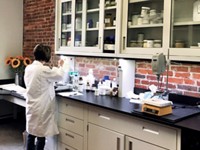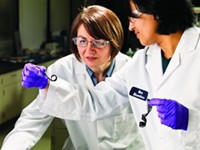Advertisement
Grab your lab coat. Let's get started
Welcome!
Welcome!
Create an account below to get 6 C&EN articles per month, receive newsletters and more - all free.
It seems this is your first time logging in online. Please enter the following information to continue.
As an ACS member you automatically get access to this site. All we need is few more details to create your reading experience.
Not you? Sign in with a different account.
Not you? Sign in with a different account.
ERROR 1
ERROR 1
ERROR 2
ERROR 2
ERROR 2
ERROR 2
ERROR 2
Password and Confirm password must match.
If you have an ACS member number, please enter it here so we can link this account to your membership. (optional)
ERROR 2
ACS values your privacy. By submitting your information, you are gaining access to C&EN and subscribing to our weekly newsletter. We use the information you provide to make your reading experience better, and we will never sell your data to third party members.
Business
Beauty before Age
Cosmetic makers look to science to unlock age-defying secrets, as FDA closely scrutinizes claims of therapeutic benefits
by PATRICIA L. SHORT, RICK MULLIN, ALEXANDER H. TULLO
May 3, 2004
| A version of this story appeared in
Volume 82, Issue 18
The signs of aging are not easy for most people to accept. Maybe it's the eyes that go first. Or maybe it's the hair as it dries, thins, and turns gray. Or maybe it's those wrinkles at the corner of the mouth or across the forehead.
While nothing short of laser surgery will reverse eyesight troubles, personal care formulators have always been ready with a host of color and coverup products to revive hair, even out skin tones, and plump up dry skin.
But over the past decade, cosmetics--the stuff of hopes and dreams--have gone well beyond the rouges, moisturizers, eyeliners, and skin softeners of the past. A new class of age-defying and skin complexion enhancers has emerged--including vitamins, fermentation products, algae derivatives, and other extracts. The makers of these ingredients say they have the studies to prove the ingredients work. And the personal care companies that employ such ingredients in their products would have consumers believe they are a veritable fountain of youth.
Maybe they are and maybe they are not. Manufacturers of "cosmeceuticals"--cosmetics with pharmaceutical-like active ingredients--walk a fine line between beauty enhancements and drugs in what they sell. The Food & Drug Administration doesn't recognize the category and now seems ready to step in where cosmetic makers claim therapeutic benefits.
Last June, FDA set the groundwork for joint oversight of cosmetics that make drug claims by two FDA units that separately regulate drugs and cosmetics. Then, early this year, the agency issued a warning letter to cosmetics maker University Medical Products charging the company with marketing unapproved new drugs.
According to FDA, the firm's skin creams promised, among other things, to reduce deep wrinkles by up to 70%; to strengthen collagen and elastin fibers; to reduce cellulite by stimulating cells and releasing stored fat; and to reduce weight through appetite suppression, increased metabolism, and fat burning. Product ingredients include retinol, green tea extract, and vitamin C.
FDA says that because the products were intended to "affect the structure or function of the body," they are drugs. Whenever a cosmetic maker claims a product cures, prevents, or mitigates disease or otherwise affects the structure or function of the human body, FDA considers that product a drug. The firm has since changed the labeling of its creams.
But cosmetic makers have plenty of wiggle space. Under a concept FDA recognizes as "puffery," it is legal to say the industry's products enhance beauty and sex appeal. Image is what the industry sells, and it is up to the consumer to believe it or not.
AND IMAGE is what consumers buy. High-end U.S. department stores sold $2 billion worth of skin preparations in 2003, up 6% compared with three years earlier, according to the NPD Group, a research firm that tracks retail sales.
Sales in the antiaging category increased 14% in 2003, more than double the 5% growth rate in each of the prior two years, NPD says. Products in the category include Estée Lauder's Re-Nutriv Ultimate Lifting Cream, which costs $250 for a 1.7-oz jar, and Perfectionist Correcting Serum for Lines and Wrinkles, at $52 for a 1-oz spray bottle.
In a break from the past, ingredient suppliers and formulators are generating clinical data to show that the newest ingredients really work, says Meyer R. Rosen, president of Interactive Consulting. Cosmetic formulators are also closely comparing the composition of younger and older skin, Rosen says. And they are extending that research to discover and include in new formulas active ingredients that increase the level of skin components that decrease in older skin.
Many antiaging formulas typically contain sunscreens to minimize the damaging effect of ultraviolet light on skin, Rosen points out. Alyson Emanuel, cosmetic ingredients director for BASF, agrees that "sunscreens do prevent photoaging of the skin," and adds that effective antiaging formulas also contain retinol and other active ingredients to reduce the appearance of lines along with anti-irritants such as the vitamin panthenol.
If the skin is not protected by sunscreens, "reactive oxygen species are generated by exposure to ultraviolet radiation and can cause oxidative damage to DNA, collagen, elastin, and lipids within the skin, leading to wrinkles," Emanuel explains. The use of antioxidants prevents this from happening.
If a formulation is designed correctly, "you can slow skin aging, but you can't reverse the aging process," says Shyam Gupta, R&D director at Arizona Natural Resources, a privately held contract formulator. However, "the majority of the products on the market are mediocre. They do not have sufficient quantities of active ingredients to provide results," he says.
It's no wonder that consumers are often confused by the competing claims formulators make, Gupta says. "It's a jungle out there now," he says, and the marketing hype invites some form of regulation.
Legitimate formulators understand the limitations on the claims they can make; they also understand that customers want something that works, says Janet C. Kosiek, home and personal care ingredients marketing manager in Degussa's Goldschmidt subsidiary. "Formulators don't want FDA in their business," and so, she asserts, "they are careful about the claims they make."
Goldschmidt itself, for instance, is using DNA chips containing genetic data to test the biological effects of specific compounds on the human epidermis to help back up the claims it makes for its ingredients. Studies employing the chips provide information on how a compound will influence biological pathways and thus suggest the physiological impact of a new compound on human skin.
Goldschmidt has tested phytosphingosine-SLC--a patented conjugate of phytosphingosine and salicylic acid--using DNA chips. The testing indicates that the conjugate increases skin ceramide content, improves skin barrier function, and down-regulates genes involved in inflammation.
Because it influences skin appearance but doesn't prevent physical aging, phytosphingosine-SLC is a useful ingredient in age-defying formulations, Kosiek says. "It minimizes the appearance of wrinkles. They may be there, but you don't see them," she says.
Responsible companies often use consumer panels to test their products before launching them in the market, Kosiek says. Something that works in the lab is not guaranteed to work once it's formulated for consumer use. And because there are many skin types, a formula may work well with one skin type but not another. Only testing with consumers will tell if a product really provides benefits, she says.
Many ingredient suppliers closely watch academic research for suggestions on new ingredients with consumer benefits. Vince Gruber, director of research and marketing development for Arch Chemical's personal care business, says a protein called cytoglobin, in part discovered by Iowa State University biochemistry professor Mark S. Hargrove and his group, "bears a striking resemblance to the protein we have been investigating from soy and lotus root nodules called leghemoglobin."
Gruber says these globin proteins may be useful for scavenging free radicals such as nitric oxide, which some researchers think is part of a biochemical cascade that is responsible for the redness caused by sunburn. Such irritation can ultimately lead to the formation of skin wrinkles. The lotus and soy root nodule derivatives Arch recently launched may therefore be useful to slow photoaging of skin, Gruber suggests.
It is important not to encroach on pharma's turf when introducing a new cosmetic ingredient, says Ratan K. Chaudhuri, cosmetics research and applications director for EMD Chemicals, the U.S. affiliate of Germany's Merck. For instance, EMD's Emblica may be best called a skin brightener or toner for cosmetic purposes rather than a skin lightener.
EMD-commissioned lab tests on human volunteers showed that Emblica, a standardized extract from the fruit of the Asian plant Phyllanthus emblica, minimizes the appearance of freckles and age spots and is also an effective antioxidant and matrix metalloprotease inhibitor. EMD has completed studies to demonstrate that, as an antioxidant, Emblica is a broad-spectrum quencher of free radicals and an inhibitor of collagenase and stromelysin, Chaudhuri says.
Nutritional supplements and even foods are considered likely skin care ingredients. Arizona Natural's Gupta considers such ingredients "nutracosmetics" and says that, with the right skin delivery systems, they can have "greater efficacy" than when they are eaten and degraded through digestion.
FOR INSTANCE, astaxanthin, a carotenoid often taken as a nutritional supplement to help prevent macular degeneration, is an especially useful antioxidant for ameliorating UV damage to skin, says Sid Hulse, sales manager at U.S. Nutraceuticals. The firm not only sells its Zanthin supercritical CO2 algae extract alone for cosmetic use, but it also sells the extract in combination with a cranberry seed oil extract "naturally high in mixed tocopherols and tocotrienols," making it a good skin emollient.
"Many cosmetic companies are going beyond traditional ingredients to nutrition and food for crossover products," says Jon Anderson, vice president of new technologies at Actives International. Probiotics, often used as nutritional supplements to complement naturally occurring microbes in the gastrointestinal tract, are the source of new extracts from Actives International. In combination with small plant-derived compounds, they act as biological response modifiers for the skin by boosting the immune system and preventing the damaging effects of UV exposure, he says.
At least one food ingredient maker has developed a significant and separate cosmetic ingredient business. Swedish vegetable oil processor Karlshamns formed its Lipids for Care business in 2000 to focus on providing customers with a specially developed family of shea oil from nuts harvested in West Africa near the Sahara desert. According to Jan Gunnerdal, president of the personal care business, shea oil is widely used to make lipsticks.
While shea lipids help provide a physical "structure" for lipstick and other cosmetics, they also have some "minor bioactivity" that is often valuable to cosmetic makers, Gunnerdal says. These emollients can protect against environmental degradation and act to screen the sun's rays, he says. The firm's studies show the lipids also have anti-inflammatory and "cell renewal" properties.

A PROBLEM for formulators of cosmetics that boast wrinkle-easing properties or antioxidant effects is designing effective "delivery systems" for the most beneficial ingredients, says Interactive Consulting's Rosen. Ingredients have to remain stable in the bottle and then must penetrate the skin under a variety of conditions. Putting a delivery system together "that gets the ingredients into the stratum corneum at the right time and the right rate" is the subject of a book Rosen is readying for publication later this year.
"Until now, aesthetics were more important than efficacy," says Johann Wiechers, principal scientist and skin care R&D manager at ICI's Uniqema unit. "Many companies have a number of standard formulations with sensory properties to which the latest new ingredient is simply added," he says. When a new active ingredient won't work in the standard formulation, it's simply tossed aside. More important is choosing an emollient system appropriate for the ingredient, he says, to make sure the ingredient can penetrate the skin.
Some ingredients are difficult to preserve long enough to be useful when a consumer opens and uses a formula that may have been sitting on a shelf for a year. Sunscreen active ingredients like avobenzone and octyl methoxycinnamate, vitamins like retinol and vitamin E, and ß-carotene are not very stable in a bottle, EMD's Chaudhuri points out.
EMD has recently developed and patented an antioxidant photostabilizer for such unstable ingredients--diethylhexyl syringylidene malonate. The company is just beginning to introduce the preservative to customers under the more easily managed trade name Oxynex ST.
While EMD's preservative will allow the consumer to dispense active ingredients, another ICI company, National Starch & Chemical, is working on systems to ensure that such ingredients don't wash down the drain. It is now developing a process for depositing active ingredients on skin that depends on some trigger, such as body pH, says James A. Mish, global marketing director for personal care.
Advertisement
The system might use an existing cationic or anionic "chassis" with which formulators are already familiar, Mish says. When, for instance, a consumer applies a body wash gel, a "triggerable event," such as the dilution of the gel, precipitates a polymer complex containing active ingredients. The event allows the active ingredients, such as a sunscreen or moisture agent, to be deposited on the skin.
It's a technology that is not yet ready for prime time, Mish says. However, within two years the firm hopes to fine-tune its triggerable deposition technology so that it will allow the formulator to control the degree and speed of penetration of the active ingredient into the skin.
Scientists will continue to work on technologies that bottle solutions for mature skin. At the same time, FDA will be keeping an eye on the science-based proof that ingredients suppliers and formulators say they are generating. In FDA's view, aging is a natural process, not a disease. Cosmetics can promise sex appeal, but they cannot be cures for what is, after all, inevitable.












Join the conversation
Contact the reporter
Submit a Letter to the Editor for publication
Engage with us on Twitter